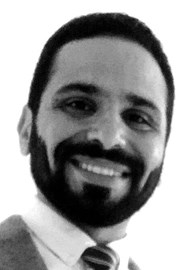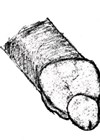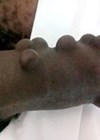What is sickle cell disease?
Sickle cell disease (SCD) is one of the most common single-gene disorders in the UK affecting approximately one in every 2000 live births. Approximately 20-25 million people worldwide have SCD. It predominately affects those of African descent, but it is also seen in Eastern Mediterranean, Middle Eastern, Indian, Caribbean and people of South and Central American descent [1].
SCD is characterised by a mutation of the haemoglobin gene (HbS). HbS polymerises when deoxygenated, which results in loss of the erythrocytes’ flexibility that normally facilitates their flow through narrow capillaries. Increased red cell adhesion and aggregation within these vessels results in vaso-occlusion and haemolysis-associated endothelial dysfunction, leading to tissue hypoxia and painful crises as well as increased red cell breakdown (haemolysis) resulting in a chronic anaemia. Several complications are linked to SCD, including: vaso-occlusive painful crises affecting the limbs or trunk, acute chest syndrome, chronic leg ulcers, pulmonary hypertension, stroke, nephropathy, avascular necrosis of the hip and priapism [2].

What is priapism?
Priapism is defined as a persistent erection lasting more than four hours, in the absence of sexual stimulation and not relieved by orgasm. It is classified into:
- Ischaemic priapism (IP); rigid and painful, a urological emergency.
- Non-ischaemic priapism (NIP); typically semi-rigid and painless.
- tuttering priapism; also known as recurrent ischaemic priapism (RIP).
Ischaemic priapism accounts for the vast majority of cases (95%). Stuttering priapism are painful ischaemic priapisms typically at night lasting less than three hours. They often resolve spontaneously or with conservative measures / oral medications.
An increasing frequency or severity of RIP episodes can be a warning sign of an impending ‘fulminant’ ischaemic priapism (i.e. an acute ischaemic priapism lasting more than four hours). It is crucial to recognise and promptly treat fulminant IP to avoid irrecoverable tissue damage from prolonged ischaemia [3].
Untreated IP will result in a compartment syndrome of the penis. Sinusoidal endothelial destruction and interstitial oedema are evident by 12 hours. Ongoing ischaemia can lead to basement membrane damage and thrombosis. By 48 hours, the development of smooth muscle necrosis and fibrosis can result in permanent erectile dysfunction (ED). Urgent and timely intervention is essential to prevent this from developing [3].
How common is SCD priapism?
SCD is the primary aetiology of IP in 23% of all adults and 63% of all paediatric cases. It is estimated that almost 72% of SCD priapism patients suffer from RIP; 75% will experience their first episode before the age of 20 [4].
Nightly RIP episodes can significantly affect a patient’s quality of life by causing chronic tiredness due to disturbed and poor-quality sleep. Despite its frequency and impact, studies have reported that the awareness of priapism as a possible complication of SCD is very poor, with only 5% recalling ever learning about it [5].
What is the mechanism of priapism in SCD?
SCD priapism is likely multifactorial. One theory is that erythrocyte sickling and increased adhesiveness of erythrocytes, leucocytes, and platelets precipitate vaso-occlusive episodes in the penis. However, this theory falls short explaining self-limiting RIP episodes, which suggest an alteration of the baseline penile haemodynamic equilibrium. A retrospective study reported that flaccid penile doppler in RIP patients showed low peripheral-resistance-waveforms with significantly higher velocities when compared to other individuals without SCD. This altered haemodynamic pattern is thought to make the development of an erection more finely balanced and easily triggered and explains the semi-rigid appearance of the flaccid penis in men with SCD RIP [6].
Nitric oxide (NO) is a key mediator in the development of a normal erection. It activates guanylate cyclase increasing cyclic guanosine monophosphate (cGMP), which in turn leads to smooth muscle relaxation resulting in an erection. Phosphodiesterase 5 enzyme (PDE5) plays a crucial role by downregulating cGMP, resulting in detumescence. In SCD patients, NO deficiency results in endothelial dysfunction and downregulation of regulatory molecules including PDE5. This NO deficiency is caused by breakdown of L-arginine (essential for NO synthesis) by arginase enzyme secreted by sickled erythrocytes. NO also binds to free HB-SS (released by intra-vascular haemolysis) resulting in further reduction in its bioavailability. With cavernosal nerve stimulation, cGMP levels can be restored resulting in smooth muscle relaxation and the development of an erection, however the PDE5 levels remains low resulting in prolonged erection [7].
Which SCD-patients are at a higher risk of priapism?
SCD is an autosomal recessive genetic disorder. The homozygous state (HB-SS) is the main risk factor for developing priapism (89.4% of cases). Studies have suggested a relationship to haemolysis severity, evidencing higher levels of serum markers of haemolysis such as lactate dehydrogenase, bilirubin, aspartate aminotransferase and reticulocyte counts in patients with SCD priapism compared to others. However, it is unclear how much of a role this association plays. High levels of circulating HbS are associated with a greater risk of ischaemic / sickling episodes, while co-inheritance of alpha-thalassemia trait and high levels of foetal haemoglobin have been found to attenuate the risk of SCD priapism [2].
How to prevent priapism in SCD patients?
Quality of life and physical wellness of men with SCD priapism is associated with the effectiveness of preventive management. Management can be divided into strategies aimed at improving the underlying SCD, and strategies aimed at modulating the erectile response. Patients are most effectively managed in a joint multidisciplinary clinic with involvement of a haematologist and urologist.
Optimal management of SCD
Hydroxyurea
Hydroxyurea has a multitude of beneficial effects on cellular and vascular function in SCD. Although it cannot cure SCD, it can significantly reduce the number and severity of painful crises, the number of hospital admissions, and the need for blood transfusions. It can also improve the quality of life and life expectancy of patients with SCD. In fact, the multicentre placebo-controlled trial investigating its efficacy had to be halted as there was such a clear benefit in the treatment arm [8]. However, its impact on fertility is often a major concern and barrier to men starting this therapy. It can cause a reversible reduction in the sperm count during treatment. Men are advised to use contraception to avoid a pregnancy during and for three months after therapy to avoid potential foetal harm. While the effects on male fertility are reversible in almost all cases, patients should be offered semen cryopreservation before commencing treatment to mitigate any potential impact on future fertility.
Newer therapies: crizanlizumab, L-glutamine, voxelotor
For almost 20 years hydroxyurea was the only approved medication for SCD. The US Food & Drug Administration (FDA) has recently approved three new agents: crizanlizumab, L-glutamine and voxelotor. Carizanlizumab is a mono-colonal antibody that binds to P-selectin, a cell membrane protein activated in inflammation that mediates adhesion of sickled erythrocytes. It represents a very promising treatment option for SCD. Its role in management of RIP is yet to be studied. L-glutamine acts as an antioxidant that maintains integrity of red cell membrane and Voxelotor inhibits polymerisation of HbS and increases its affinity to oxygen. Crizanlizumab has been made available in the NHS since October 2021 [9].
Red cell exchange transfusion (ET)
Risk of priapism is linked to the HbS percentage. Removal of the patient’s sickle cells in exchange for exogenous normal red cells improves the oxygen carrying capacity while reducing blood viscosity and reducing the propensity for vaso-occlusive and haemolytic events. ET can effectively improve SCD priapism. The aim is to reduce the HbS to <30%. Earlier small series reported the development of significant neurological events when performing ET in priapism (ASPEN syndrome), but this may have been related to increased blood viscosity in those cases and issues were not seen in subsequent ET series with apheresis keeping the Hb<10g/dl [10].
Avoidance of priapism triggers
Medications and recreational drugs including antipsychotics, antidepressants, cocaine, marijuana and excess alcohol can trigger priapic episodes, and advice to avoid these should be given.
Nocturnal hypoxia / oxygen
Sleep disordered breathing (SDB) is present in approximately 44-50% of adults with SCD. This includes obstructive sleep apnoea, and transient nocturnal hypoxic episodes, which may exacerbate RIP during normal nocturnal tumescence episodes. The UK SCD Standards recommend that a sleep study should be advised in SCD patients with: • Self-reports of disturbed sleep • Excessive daytime sleepiness • Low oxygen saturations when awake (<95%) • A history of snoring, priapism or early morning headaches. Patients with abnormal sleep studies should be referred to a respiratory physician for review and consideration of nocturnal oxygen therapy.
Modulation of the erectile response
Alpha adrenergic agents
Sympathetic stimulation of corporal tissue induces cavernosal vaso-constriction resulting in detumescence. Intra-cavernosal injection of alpha-adrenergic agents such as phenylephrine have been a mainstay in the acute management of IP. Regular nocturnal dosing with oral alpha-adrenergic agonists such as etilefrine can effectively prevent RIP by maintaining an overriding sympathetic tone. Although it is well tolerated, blood pressure should be monitored in those on higher doses to exclude secondary hypertension [11].
PDE5 inhibitors
Use of phosphodiesterase type 5 (PDE5) inhibitors to prevent priapism might seem an irony given its common use for treating erectile dysfunction. However, good understanding of the pathophysiology of SCD-priapism which results from NO / cGMP/ PDE5 imbalance justifies the rationale of its use: it restores tonic cGMP levels in corporal tissues while also controlling reactive oxygen species formation, thereby correcting the molecular dysregulation. Several small studies have shown some efficacy of the strategy, prompting its use as a second-line strategy after oral alpha-adrenergic agents [11].
Hormonal therapies
Suppression of androgenic activity can be an effective treatment, however this comes at the cost of significant long-term side-effects of hypogonadism including loss of libido, infertility and adverse cardiovascular effects. Peripherally acting antiandrogens such as cyproterone have been reported to be effective, but their impact on normal sexual function, fertility and liver function limit their use to a shorter-term strategy in more difficult cases.
5-alpha reductase inhibitors, which inhibit the conversion of testosterone to its more potent derivative dihydrotestosterone (DHT), have also been used as an alternative with studies reporting a complete resolution in 43% of cases [11].
What is the acute management of ischaemic priapism in SCD?
Management of stuttering episode
Self-treatment approaches are first line with any RIP. These include exercise, keeping well hydrated, taking analgesia, voiding, ejaculation and a warm (never cold) bath / shower. Those on etilefrine can take an additional dose. In well-selected patients, self-injection of intra-corporal phenylepherine can be an effective strategy for decreasing ED visits and admissions [12].
Urgent clinical attention is required if these measures do not work. Patients with sickle cell priapism should have a lower threshold for attending their local emergency department (painful priapism lasting less than two hours).
Stepwise management of a fulminant episode
- Confirm the diagnosis: Priapism is a clinical diagnosis (IP – rigid painful shaft, soft glans). The clinician should ask about:
- Duration of current priapism.
- What has been tried already.
- Patterns of typical sickle crises.
- Previous priapisms – RIP and fulminant episodes (how long they lasted).
- What treatment was required (previous aspirations / shunts / surgery).
- Details of SCD treatment.
- What painkillers they typically use for painful crises.
- Other possible precipitants to priapism (medication or recreational drugs).
- Their normal baseline erectile function.
2. Give analgesia and alert the haematology on call
- Ensure the patient is well hydrated, oxygenated and warm.
- Obtain IV access and send bloods for a full blood profile (FBC, LFT, U&Es, coagulation profile) with assessment of the red cell count with differential, and HbS percentage measurement.
- Haematology may consider ET.
3. Do a penile block:
- Use a combination of short and long-acting local anaesthetic for pain control, and to allow for subsequent aspirations (plain lignocaine/ bupivacaine).
4. Aspirate corporal cavernosal blood through the glans or lateral aspect of the shaft using a 19G needle.
- Send corporal blood for blood gas analysis to confirm the ischaemic diagnosis (low pO2 and acidic pH).
- Aspirate until fresh red blood is seen. Repeat blood gas can be sent to ensure ischaemia resolved. Be mindful of volume aspirated (<100cc).
5. Intracavernosal (IC) injection of an alpha-adrenergic agent:
- Phenylephrine (each ampoule typically contains 10mg in 1ml; dilute whole vial with 49ml normal saline to give a final concentration of 200μg in 1ml).
- Give 200μg in 1ml doses every 5-10 minutes, up to a maximum of 1000 mcg – monitor BP/P throughout.
6. If painful ischaemic priapism persists do a corporal washout:
- With sterile normal saline suitable for IV use in theatre followed by a repeat of IC phenylephrine (can be more effective after washout).
7. If persistent rigid ischaemic priapism despite washout:
- Consider a percutaneous distal shunt (Winter shunt as a minimum, or T shunt).
8. If shunt fails:
- Discuss and demonstrate penile prosthesis (typically semi-rigid initially, which can be exchanged at a later date).
- Plan for delayed insertion to allow any larger distal (T) shunt to close (consider doing at three weeks). Optimise SCD in interim and see prosthesis nurse for counselling. Ensure adequate analgesia and antibiotic cover while awaiting surgery.
9. If late presentation with episode lasting more than 48 hours, a primary penile implant is recommended as a distal shunt is unlikely to be successful at this stage and the patient will inevitably develop complete erectile dysfunction [13]. A T2 weighted MRI scan of the penis with gadolinium contrast may be useful to diagnose changes and fibrosis associated with smooth muscle necrosis due to prolonged ischaemia, which can aid the decision-making process for whether or not to proceed to an implant in such cases.
How can we optimise management for SCD priapism patients?
Prevention is the best approach.
Educate men from an early age about SCD priapism to encourage early presentation with painful episodes and allow early intervention.
Raise awareness among communities and front-line healthcare professionals to improve understanding of the condition and the different treatment options.
Optimise management of the underlying sickle cell disease.
Avoid concurrent priapism triggers.
Early control of RIP episodes with effective measures to prevent more fulminant episodes.
Close monitoring in specialist joint clinics to optimise care and mitigate the long-term impact of the condition.
Improved access to healthcare in both specialised clinics and A&E to allow rapid and timely intervention.
TAKE HOME MESSAGE
There is no ‘one-size-fits-all’ management for SCD-RIP patients. SCD patients should be managed in a specialised multidisciplinary clinic jointly by a haematologist, urologist, and a specialist nurse.th Patients should be provided with adequate information about their condition, including potential benefits and side-effects of different treatment options. Regular follow-up with easy access for those developing problems between appointments is essential to ensure an effective response to treatment and to prevent acute exacerbations and IP episodes.
References
1. Piel FB, Patil AP, Howes RE, et al. Global epidemiology of sickle haemoglobin in neonates: a contemporary geostatistical modelbased map and population estimates. Lancet 2013;381:142-51.
2. Ahuja G, Ibecheozor C, Okorie NC, et al. Priapism and sickle cell disease: special considerations in etiology, management, and prevention. Urology 2021;156:e40-7.
3. Broderick GA, Kadioglu A, Bivalacqua TJ, et al. Priapism: pathogenesis, epidemiology, and management. J Sex Med 2010;7:476-500.
4. Adeyoju AB, Olujohungbe AB, Morris J, et al. Priapism in sickle cell disease; incidence, risk factors and complications - an international multicentre study. BJU Int 2002;90:898-902.
5. Bennett N, Mulhall J. Sickle cell disease status and outcomes of African-American men presenting with priapism. J Sex Med 2008;5(5):1244-50.
6. Patel U, Sujenthiran A, Watkin N. Penile doppler ultrasound in men with stuttering priapism and sickle cell disease -- a labile baseline diastolic velocity is a characteristic finding. J Sex Med 2015;12(2):549-56.
7. Morrison BF, Burnett AL. Stuttering priapism: insights into pathogenesis and management. Curr Urol Rep 2012;13:268-76.
8. Charache S, Barton FB, Moore RD, et al. Hydroxyurea and sickle cell anemia. Clinical utility of a myelosuppressive “switching” agent. the multicenter study of hydroxyurea in sickle cell anemia. Medicine (Baltimore) 1996;75(6):300-26.
9. Cisneros GS, Thein SL. Recent advances in the treatment of sickle cell disease. Front Physiol 2020;11:435.
10. Ballas SK, Lyon D. Safety and efficacy of blood exchange transfusion for priapism complicating sickle cell disease. J Clin Apher 2016;31(1):5-10.
11. Joice GA, Liu JL, Burnett AL. Medical treatment of recurrent ischaemic priapism: a review of current molecular therapeutics and a new clinical management paradigm. BJU Int 2021;127(5):498-506.
12. Teloken C, Ribeiro EP, Chammas MJ, et al. Intracavernosal etilefrine self-injection therapy for recurrent priapism: one decade of follow-up. Urology 2005;65:1002.
13. Zacharakis E, Raheem AA, Freeman A, et al. The efficacy of the T-shunt procedure and intracavernous tunneling (snake maneuver) for refractory ischemic priapism. J Urol. 2014 Jan;191(1):164-8.
Declaration of competing interests:
MS has been paid by Boston Scientific for running educational programmes in andrology and presenting at conferences. He has also received funding for research into post prostatectomy care from the company.
YI has no conflicts of interest.










